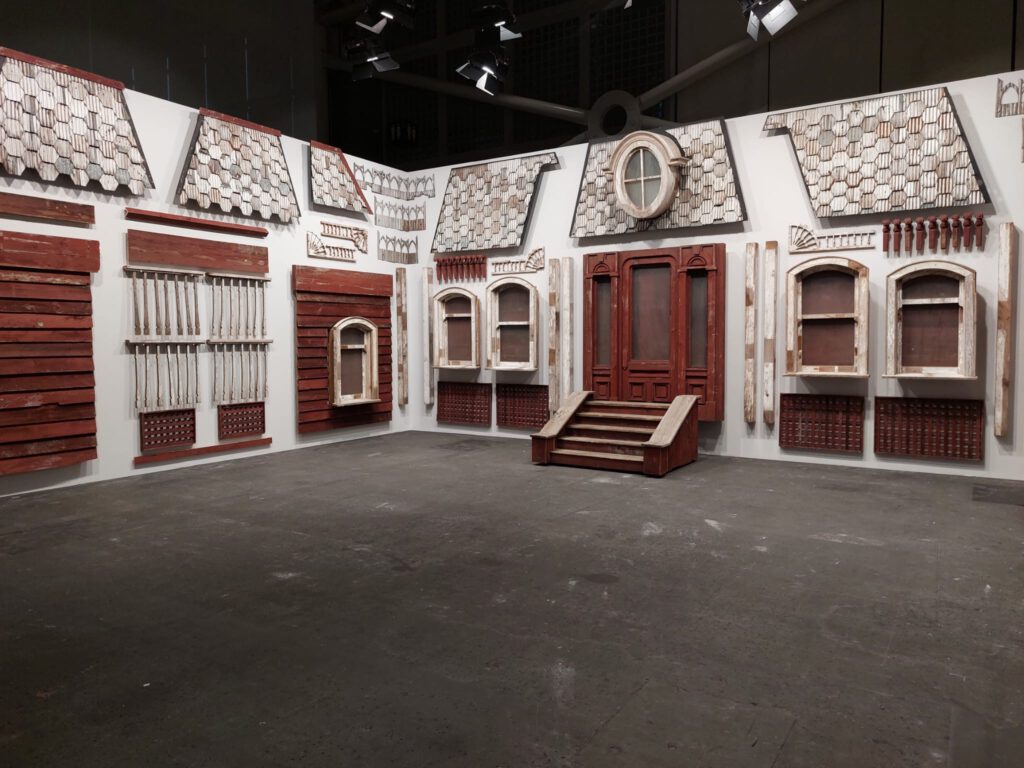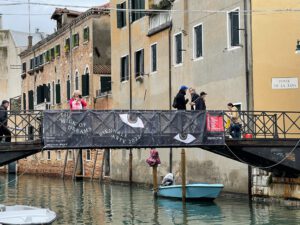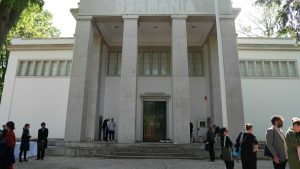Text and Photos by Cordelia Kapfer
Art Basel Unlimited 2023 has once again set the stage for an in-depth exploration of contemporary art, with a notable emphasis on the contributions of women artists. This year’s edition is notable for the diversity and depth of exploration presented by these artists, who explore a range of themes from identity and memory to ecology, technology and beyond. Their works, which vary in medium and scale, offer a nuanced dialogue with the contemporary moment, reflecting the complexities of our time through a distinctly feminist lens.
One of the highlights of the exhibition is the innovative use of materials and forms to address socio-political issues. Through installations, paintings, sculptures and multimedia projects, the female artists of Art Basel Unlimited 2023 have deftly navigated the intersections of gender, culture and power. Their art transcends aesthetic contemplation and serves as a catalyst for dialogue and reflection on pressing global concerns.
Here are a few of the women artists who showcased their innovative and thought-provoking work, each bringing unique perspectives and mediums to the forefront of contemporary art.

Art Basel Unlimited 2023, Photo©Cordelia Kapfer
Firelei Báez (born 1981, Dominican Republic)
Firelei Báez’s contribution to Art Basel Unlimited 2023, „the vast ocean of all possibilities“ (2022), marks a continuation of her deep engagement with themes of history, identity and transformation through the lens of Caribbean heritage and diaspora. Born in the Dominican Republic and now based in New York, Báez has consistently used her art as a medium to explore the nuanced narratives of cultural heritage, memory and the complexities.
In „the vast ocean of all possibilities“, Báez once again turns her attention to the Sans-Souci Palace in northern Haiti, a site emblematic of both the grandeur and the tumultuous history of the Caribbean. Through her reimagining of the archaeological ruins, Báez doesn’t simply present a historical narrative, but offers a vision that is as much about the future as it is about the past. Her work transcends traditional boundaries between time periods, inviting viewers to consider the interconnectedness of history, the present, and the myriad possibilities of the future.
The choice of the Sans-Souci Palace is particularly poignant, serving as a symbol of resilience and sovereignty, as well as a reminder of the region’s colonial past and the revolutions that have shaped its present. By focusing on this site, Báez engages in a dialogue with history that acknowledges the pain and destruction wrought by colonialism colonialism, while celebrating the indomitable spirit of resistance and the capacity for renewal and transformation inherent in the Caribbean people and their diaspora.
Báez’s work is characterised by a rich visual language that combines intricate patterns, vibrant colours and a meticulous attention to detail. This not only captivates the viewer aesthetically, but also encourages a deeper engagement with the layers of meaning embedded within the work. The title itself, ‚the vast ocean of all possibilities‘, suggests a boundless horizon of possible futures and invites contemplation on how understanding and reinterpreting the past can open up new avenues for identity and cultural expression.

Conny Maier
At Art Basel Unlimited 2023, German artist Conny Maier – presented by Société – showcased the large-scale painting „The Source“, which delves deeply into the existential questions facing humanity and our environment. Maier’s art, known for its distinctive off-kilter figuration, is characterised by a keen exploration of the complex and often precarious relationships between species, painting a vivid picture of the vulnerabilities and uncertainties that define our existence.
Maier’s paintings are a rich tapestry of inter-species entanglements, each brushstroke weaving together stories of dominance, control, and the often blurred lines between. Through her art, she articulates a sense of precarity and vulnerability as fundamental conditions of life, challenging the viewer to confront these realities head-on. Her work is a reflection on the stark polarities that define our world—dominance and submission, stability and chaos, the human and the non-human—inviting us to ponder the implications of these dichotomies.
What sets Maier’s work apart is her unflinching examination of the twilight of the Anthropocene. Her paintings are not just a critique but a question posed to humanity: what end are we hurtling towards, and what new beginnings can we imagine in its wake? Maier’s art suggests that the answers lie not in a simple return to what was, but in the embrace of a new equilibrium, one that acknowledges our entanglement with the non-human world and seeks harmony within it. Through her masterful use of figuration and narrative, Maier invites us to reflect on the precariousness of our existence and the possibility of transformation. Her work is a clarion call to recognise the vulnerabilities that bind us to each other and to the planet, urging us towards a future where balance and understanding can flourish. In a world teetering on the brink of ecological collapse, Maier’s paintings emerge as a beacon of hope, envisioning a new day dawning from the twilight of the Anthropocene.

Selma Selman (born in 1991, Bosnia and Herzegovina)
Selma Selman’s presentation at Art Basel Unlimited 2023 underscores her position as an avant-garde artist from the former Yugoslav region, adept at weaving critical commentary and political narratives through a variety of media, including performance, video, photography, drawing and painting. Born in 1991 in Bihać, Bosnia and Herzegovina, Selman’s work at the fair represents a bold continuation of her exploration of themes of identity, cultural norms and the commodification of status symbols within her Roma heritage.
Her piece for Art Basel Unlimited, a large-scale altar-like painting composed of dismantled car parts, is both an artistic and technical feat. Transforming a car bonnet, doors and boot lid into a six-part sculptural installation, Selman transcends conventional painting surfaces, creating a dynamic interplay between the industrial coldness of metal and the organic warmth of her painted forms. These forms, characterised by their delicate, hybrid forms reminiscent of eerie human bodies with elongated, spider-like limbs and variably closed or multiplied eyes, merge into one another. This fusion results in a compelling visual narrative that is both unsettling and captivating, emphasising the contrast between the mechanised parts and the softness of the painted figures.
This work at Art Basel Unlimited is not an isolated endeavour, but rather a continuation of Selman’s artistic dialogue on the themes of transformation and resilience. It echoes her previous works, such as the painting installation ‚Six Pieces of Mercedes-Benz‘ (2022) and the video performance ‚Mercedes Matrix‘ (2019), in which the dismantling of a Mercedes-Benz – a powerful symbol of wealth and status in her native Romani community and beyond – served as a powerful act of deconstruction. Through this recurring motif, Selman critiques the societal values placed on material possessions and interrogates notions of value, ownership and identity.
Selman’s work is particularly poignant in its evocation of the fragility and ferocity of female spiders, a metaphor that enriches her exploration of female strength and vulnerability. By incorporating elements from her preparatory drawings into the final installation, she invites viewers to consider the complexity of female identities, challenging them to confront their own perceptions of strength, resilience and the societal roles imposed on women.

Nancy Holt (April 5, 1938 – February 8, 2014, USA)
At Art Basel 2023, Nancy Holt’s Mirrors of Light I, presented by Sprüth Magers Gallery, is a testament to her enduring legacy as a pioneering figure in the fields of earth, land and conceptual art. This expansive installation encapsulates Holt’s lifelong exploration of the interplay between light, perception and space, inviting viewers into an immersive experience that transcends the visual to become deeply sensual and introspective.
Holt, who passed away in 2014, left behind a body of work that continues to resonate for its innovative approach to site-specific installations and experimental moving images. Born in Worcester, Massachusetts, in 1938, her career spanned over five decades, during which she consistently challenged and expanded the boundaries of how art interacts with and interprets the natural world. „Mirrors of Light I“ is a prime example of her ingenuity and her ability to harness simple elements to profound effect.
The installation employs ten circular mirrors and a single spotlight to transform and materialise light in an almost alchemical way. The light from the spotlight, captured and reflected by the mirrors, creates dynamic projections that dance across the space. These projections do not simply scatter light; they give it weight, texture and movement, making the intangible not only visible but almost tangible. This manipulation of light and reflection creates a unique environment where the boundaries between the natural and the artificial are blurred and new possibilities for perception are fostered.
What is particularly striking about Mirrors of Light I is its ability to engage the viewer as an active participant rather than a passive observer. The installation’s configuration invites movement, encouraging visitors to navigate the space and experience the shifting interplay of light and shadow from different vantage points. This interaction underscores Holt’s interest in the relational aspects of art – how objects, spaces and individuals are connected through the act of viewing and experiencing.
Beyond its aesthetic and sensory appeal, Holt’s work serves as a conceptual investigation into the nature of seeing and the mechanisms by which we interpret our surroundings. By focusing on light – a fundamental yet often overlooked component of both art and everyday life – Holt raises questions about the ways in which we construct and understand reality. The installation becomes a space for contemplation, not only of the art itself, but of the broader implications of perception, system and place in our lives.
In presenting Mirrors of Light I at Art Basel 2023, the exhibition not only pays homage to Nancy Holt’s groundbreaking contributions to contemporary art, but also highlights her role as a visionary thinker. Her work, characterised by a deep engagement with the environment and a nuanced understanding of the material and immaterial, offers a rich terrain for exploration and interpretation. „Mirrors of Light I exemplifies the enduring relevance of Holt’s artistic investigations, proving that her explorations of light, perception and place continue to enlighten and inspire.

Photo©Cordelia Kapfer
Cornelia Parker (born 1956 in Cheshire, United Kingdom)
Cornelia Parker’s installation, „PsychoBarn (Cut Up),“ showcased at Art Basel 2023, stands as a profound testament to her enduring fascination with architectural forms, cinematic narratives, and the transformative potential of materials. Building on her acclaimed 2016 work „Transitional Object (PsychoBarn),“ originally commissioned by the Metropolitan Museum in New York, Parker revisits the iconic imagery of the mansion from Alfred Hitchcock’s 1960 thriller „Psycho.“ In this iteration, however, she employs a Dada-inspired cut-up technique to deconstruct and reassemble the architectural elements into a new, exploded composition.
Parker’s „PsychoBarn (Cut Up)“ dismantles the familiar and unsettling architecture of the Psycho mansion, recontextualising elements of an archetypal American red barn to challenge our perceptions of space, structure, and narrative. The installation’s components, including windows, doors, panels, and the corrugated metal roof, bear the marks of weathering from their transatlantic journey, imbuing the work with a sense of history and temporality. These pieces are meticulously arranged in a salon-style hanging that envelops the viewer, with some elements spilling onto the floor, creating an immersive environment that oscillates between construction and deconstruction.
The choice to present the components of the barn in a fragmented, inside-out manner evokes a sense of disorientation and reflection on the nature of assembly and disassembly. This method draws parallels with the Dadaist movement’s embrace of chance, absurdity and critique of traditional values, while also engaging with contemporary discussions of fragmentation, memory and the passage of time.
Parker’s work is characterised by her ability to imbue the inanimate with intense psychological depth, and ‚PsychoBarn (Cut Up)‘ is no exception. By dissecting and rearranging the familiar forms of the barn and Psycho’s mansion, she not only references the psychological tension inherent in Hitchcock’s film, but also invites the viewer to consider the psychological implications of space and architecture. The installation becomes a place of contemplation where the boundaries between inside and outside, past and present, stability and precariousness are blurred.
Another highlight was Monica Bonvicini’s ‚Never Again‘ (2005), a powerful installation of swings made of steel pipes, black leather, belts and chains. The work, presented by several galleries, explores psychoanalysis and sexuality, examining how spaces influence behaviour. Bonvicini’s work often challenges social norms and the relationship between architecture, power and gender.
Diamond Stingily’s ‚How Did He Die‘ (2016) is a powerful installation, featuring a single-channel projection of black and white footage of young girls in a schoolyard engaged in call-and-response songs and dance routines. Projected through a freestanding chain-link fence, the work juxtaposes classical austerity with lyrical and melancholy qualities, offering a reflection on memory, community and childhood innocence.



